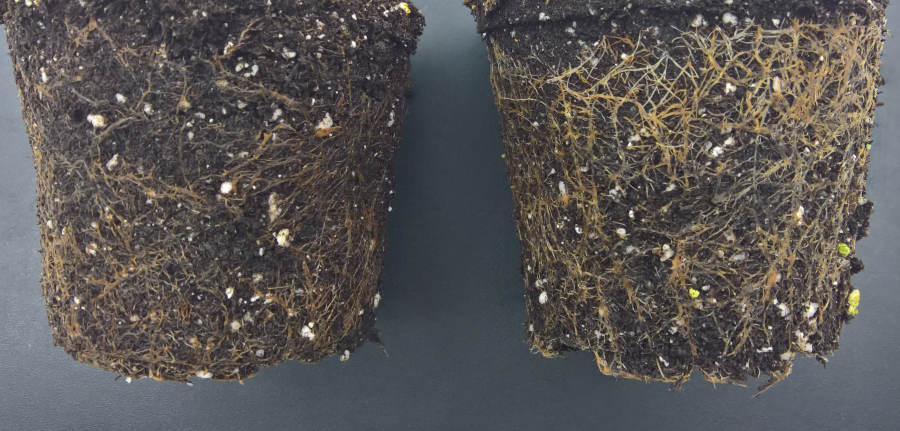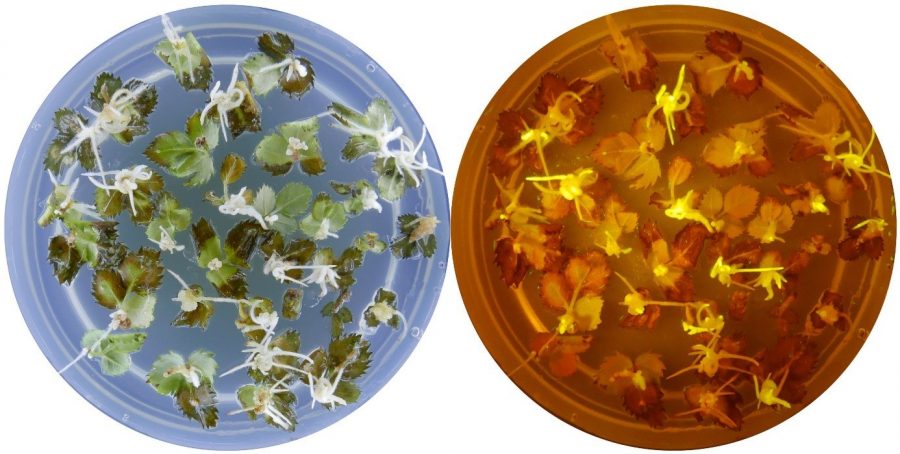Brochure Have scientists found a key to make plants more stress tolerant with “hairy roots”?
Philipp Rüter, Ellen De Keyser, Traud Winkelmann. Translated to Romanian by Cristian Sisea and Adriana Aurori
Brochure article (page 32-35)
Can more drought tolerant plants be bred by exposing their tissues to specific soil bacteria in the lab? Plant scientists know for some time that they can use this "bacterial breeding" to alter a plant's root and shoot characteristics. In ornamentals, it has already resulted in varieties with a more compact and thus more attractive growth habit. Whether it is also successful in making chrysanthemum, sunflower, apple and rose more stress tolerant is the question that will be investigated in the new project RootsPlus during the next two years. "The technique is difficult and plant-dependent, but you obtain a market-ready new cultivar much faster than with other breeding techniques," says project coordinator Ellen De Keyser (ILVO, Belgium).
Climate change and drought are urgent challenges in agriculture and horticulture
Climate change poses many challenges to plant production. In the event of persistent drought, for example, crops will not find sufficient moisture and nutrients through their roots. Because they also lose more moisture through evaporation, they suffer from 'drought stress'. "That usually results in a growth retardation or stagnation. More seriously, it can lead to withering that the plant does not recover from when it finally does rain. This year was an exception, but harvest and quality losses due to drought stress have become more common in recent years," says Emmy Dhooghe (ILVO RootsPlus researcher).
Soil bacteria stimulate the growth of hairy roots
Finding solutions to better arm plants against drought stress is therefore an important task for plant scientists. The soil bacterium Rhizobium rhizogenes, which is abundantly present in nature, could play an important role in this. When a piece of leaf or stem is cultivated in a Petri dish together with this bacterium, it transfers part of its DNA (the T-DNA) to the DNA of the plant, just like in nature. Under the influence of this T-DNA, the plant tissue forms a new type of roots, also called 'hairy roots' because they are highly branched and carry may root hairs. From these hairy roots, plant scientists can then grow new plantlets, which in turn often form more elongated or finely branched roots (Figure 1). And that can be an interesting feature in dry years.

Logical link between root morphology and drought tolerance
In dry periods, plants must be able to absorb a lot of water after each short, heavy rainfall. Plants with widely branched, superficial root systems can have an advantage here, compared to plants with one deep taproot. Thus, altered root morphology can affect a plant's ability to take up water from the soil.
Faster drought-tolerant breeding
"Through classical plant breeding, we would only after an extensive period of time be able to achieve this. Creating hairy roots is really unique to bacterial breeding (outside of GMO legislation) and in that sense represents an acceleration in breeding towards drought tolerance." (Ellen De Keyser, ILVO, Belgium).
Nevertheless, it will be some time before we find drought-tolerant plants on the market that have descended from hairy roots. After all, not all in vitro grown plants develop an extensive root system, and in addition to root morphology they also need to be evaluated for drought tolerance. Only the champion plants that score well in both areas will then be selected for further cross-breeding. "Depending on the crop, this can yield more climate-resistant plants within 5 to 10 years that can be directly used in breeding commercial varieties." (Ellen De Keyser, ILVO, Belgium).
RootsPlus will work with chrysanthemum as a model crop for herbaceous plants, rose and apple as model plants for woody plants, and sunflower as a model plant for agricultural and industrial crops.
Also a strategy against soil fatigue or replant disease
For apple and rose, RootsPlus poses a second research question: can bacterial engineering and the modified root system also increase the tolerance of the tree or shrub to soil fatigue or replant disease? In this phenomenon, roses and apple trees suffer from depressed growth and a defective root system when they are planted at a site where roses and apple trees were planted previously. The exact cause of this phenomenon is not known but one notices a disturbed morphological and physiological response of the plant to the altered soil life (microbiome). We intend to find out if the strong root growth provoked by the genes of the soil bacteria can overcome this problem. (Traud Winkelmann, Leibniz University Hannover, Germany).
Establishment of a rose transformation protocol
In the following we will summarize the first steps taken towards applying “bacterial breeding” in rose. The first step in order to regenerate plantlets from hairy roots, is to identify conditions under which a lot of hairy roots are formed. For this purpose, many parameters can be considered, for example the bacterial density, incubation time, composition of the culture media, explant type (leaf, hypocotyl, internodes) or the wounding method. Wounds are the entry sites for the bacteria into the plant tissue and thus optimizing the wounding method is considered crucial for an efficient transformation protocol.
Since hairy roots cannot be easily distinguished from normal adventitious roots, we used a R. rhizogenes strain carrying a binary vector containing the reporter gene GFP (green fluorescent protein). Under blue-green LED light with an orange filter, transformed fluorescent roots could be identified easily (Figure 2).

